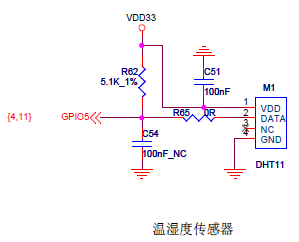前边的文章中我们以开发快”小E"为例,学习了使用Arduino IDE开发ESP8266。
包括安装Arduino core for ESP8266 WiFi chip以及实现板载RGB LED8个颜色的交替闪烁等。
并且在另一篇文章中讲述了如何通过MQTT 控制ESP8266 (开发快”小E")板载 LED。
而开发快”小E"的板载硬件极其丰富,除了板载RGB LED外,还包含但不限于OLED显示屏、DHT11温湿度计等。
此例中我们测试使用DHT11温湿度计。
原理图
开发快”小E"用的是AOSONG的DHT11模块,VDD为电源,可接直流3.3-5.5V。
以下为从炫球大神的帖子中扒到的DHT11连接图,看起来与在Arduino UNO上连线没啥区别。
唯一需要注意的是DATA连接到GPIO5上,我们的程序中要做对应的修改。

代码
既然接线啥的没啥区别,那么在Arduino 开发环境下,代码也应该没啥区别吧。
在Arduino官网上找到一个DHT11库:
http://playground.arduino.cc/Main/DHT11Lib
露点(Dew Point)啥的咱不去关注(话说净网行动不允许露点!!!)
啥开氏温度(kelvin temperature)以及华氏温度(Fahrenheit temperature),咱们也不去管。
所以精简后的代码如下:
ESP8266_DHT11.ino
-
#include "dht11.h"
-
-
dht11 DHT11;
-
#define DHT11PIN 5
-
-
void setup()
-
{
-
Serial.begin(115200);
-
}
-
-
void loop()
-
{
-
Serial.println("\n");
-
-
int chk = DHT11.read(DHT11PIN);
-
-
Serial.print("Read sensor: ");
-
switch (chk)
-
{
-
case DHTLIB_OK:
-
Serial.println("OK");
-
break;
-
case DHTLIB_ERROR_CHECKSUM:
-
Serial.println("Checksum error");
-
break;
-
case DHTLIB_ERROR_TIMEOUT:
-
Serial.println("Time out error");
-
break;
-
default:
-
Serial.println("Unknown error");
-
break;
-
}
-
-
Serial.print("Humidity (%): ");
-
Serial.println((float)DHT11.humidity, 2);
-
-
Serial.print("Temperature (°C): ");
-
Serial.println((float)DHT11.temperature, 2);
-
-
-
delay(2000);
-
}
-
//
-
// END OF FILE
- //
dht11.h
-
//
-
// FILE: dht11.h
-
// VERSION: 0.4.1
-
// PURPOSE: DHT11 Temperature & Humidity Sensor library for Arduino
-
// LICENSE: GPL v3 (http://www.gnu.org/licenses/gpl.html)
-
//
-
// DATASHEET: http://www.micro4you.com/files/sensor/DHT11.pdf
-
//
-
// URL: http://playground.arduino.cc/Main/DHT11Lib
-
//
-
// HISTORY:
-
// George Hadjikyriacou - Original version
-
// see dht.cpp file
-
//
-
-
#ifndef dht11_h
-
#define dht11_h
-
-
#if defined(ARDUINO) && (ARDUINO >= 100)
-
#include <Arduino.h>
-
#else
-
#include <WProgram.h>
-
#endif
-
-
#define DHT11LIB_VERSION "0.4.1"
-
-
#define DHTLIB_OK 0
-
#define DHTLIB_ERROR_CHECKSUM -1
-
#define DHTLIB_ERROR_TIMEOUT -2
-
-
class dht11
-
{
-
public:
-
int read(int pin);
-
int humidity;
-
int temperature;
-
};
-
#endif
-
//
-
// END OF FILE
- //
dht11.cpp
-
//
-
// FILE: dht11.cpp
-
// VERSION: 0.4.1
-
// PURPOSE: DHT11 Temperature & Humidity Sensor library for Arduino
-
// LICENSE: GPL v3 (http://www.gnu.org/licenses/gpl.html)
-
//
-
// DATASHEET: http://www.micro4you.com/files/sensor/DHT11.pdf
-
//
-
// HISTORY:
-
// George Hadjikyriacou - Original version (??)
-
// Mod by SimKard - Version 0.2 (24/11/2010)
-
// Mod by Rob Tillaart - Version 0.3 (28/03/2011)
-
// + added comments
-
// + removed all non DHT11 specific code
-
// + added references
-
// Mod by Rob Tillaart - Version 0.4 (17/03/2012)
-
// + added 1.0 support
-
// Mod by Rob Tillaart - Version 0.4.1 (19/05/2012)
-
// + added error codes
-
//
-
-
#include "dht11.h"
-
-
// Return values:
-
// DHTLIB_OK
-
// DHTLIB_ERROR_CHECKSUM
-
// DHTLIB_ERROR_TIMEOUT
-
int dht11::read(int pin)
-
{
-
// BUFFER TO RECEIVE
-
uint8_t bits[5];
-
uint8_t cnt = 7;
-
uint8_t idx = 0;
-
-
// EMPTY BUFFER
-
for (int i=0; i< 5; i++) bits[i] = 0;
-
-
// REQUEST SAMPLE
-
pinMode(pin, OUTPUT);
-
digitalWrite(pin, LOW);
-
delay(18);
-
digitalWrite(pin, HIGH);
-
delayMicroseconds(40);
-
pinMode(pin, INPUT);
-
-
// ACKNOWLEDGE or TIMEOUT
-
unsigned int loopCnt = 10000;
-
while(digitalRead(pin) == LOW)
-
if (loopCnt-- == 0) return DHTLIB_ERROR_TIMEOUT;
-
-
loopCnt = 10000;
-
while(digitalRead(pin) == HIGH)
-
if (loopCnt-- == 0) return DHTLIB_ERROR_TIMEOUT;
-
-
// READ OUTPUT - 40 BITS => 5 BYTES or TIMEOUT
-
for (int i=0; i<40; i++)
-
{
-
loopCnt = 10000;
-
while(digitalRead(pin) == LOW)
-
if (loopCnt-- == 0) return DHTLIB_ERROR_TIMEOUT;
-
-
unsigned long t = micros();
-
-
loopCnt = 10000;
-
while(digitalRead(pin) == HIGH)
-
if (loopCnt-- == 0) return DHTLIB_ERROR_TIMEOUT;
-
-
if ((micros() - t) > 40) bits[idx] |= (1 << cnt);
-
if (cnt == 0) // next byte?
-
{
-
cnt = 7; // restart at MSB
-
idx++; // next byte!
-
}
-
else cnt--;
-
}
-
-
// WRITE TO RIGHT VARS
-
// as bits[1] and bits[3] are allways zero they are omitted in formulas.
-
humidity = bits[0];
-
temperature = bits[2];
-
-
uint8_t sum = bits[0] + bits[2];
-
-
if (bits[4] != sum) return DHTLIB_ERROR_CHECKSUM;
-
return DHTLIB_OK;
-
}
-
//
-
// END OF FILE
- //
把这三个文件放到ESP8266_DHT11目录下,编译并上传到开发快”小E"。
然后打开串口监视器,就可以看到每隔两秒输出如下信息:
-
-
Read sensor: OK
-
Humidity (%): 46.00
-
Temperature (°C): 30.00
-
总结
好吧,这个例子比较简单,拿来就可以用了。
但是恰恰是这个简单的例子,说明了使用Arduino IDE开发ESP8266是非常简单的事情。
很多库可以不做修改或者做简单的修改就可以在ESP8266上用喽。
谨以本文抛砖引玉,希望大家折腾出更好玩的东西。

 我要赚赏金
我要赚赏金

